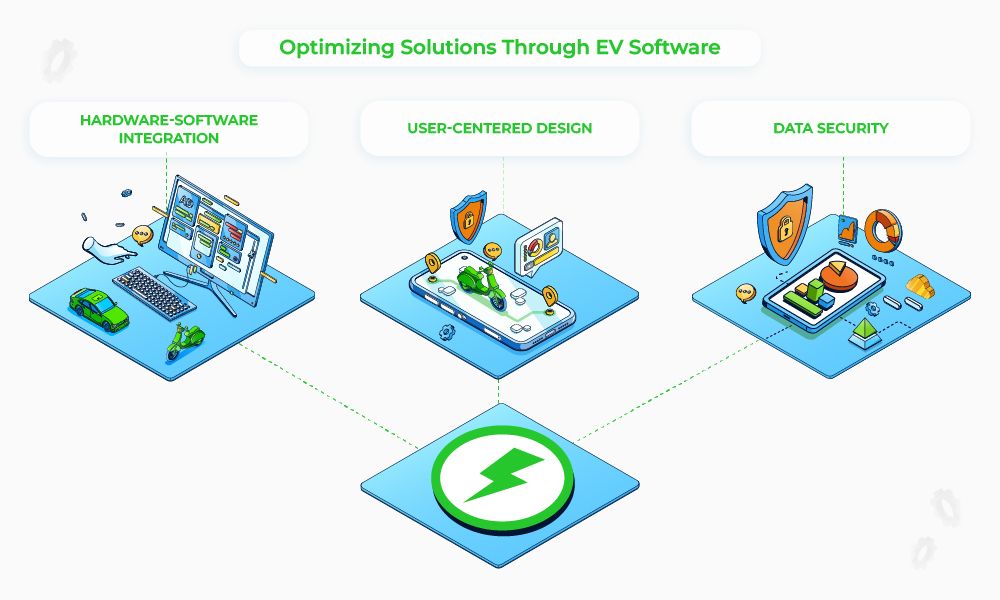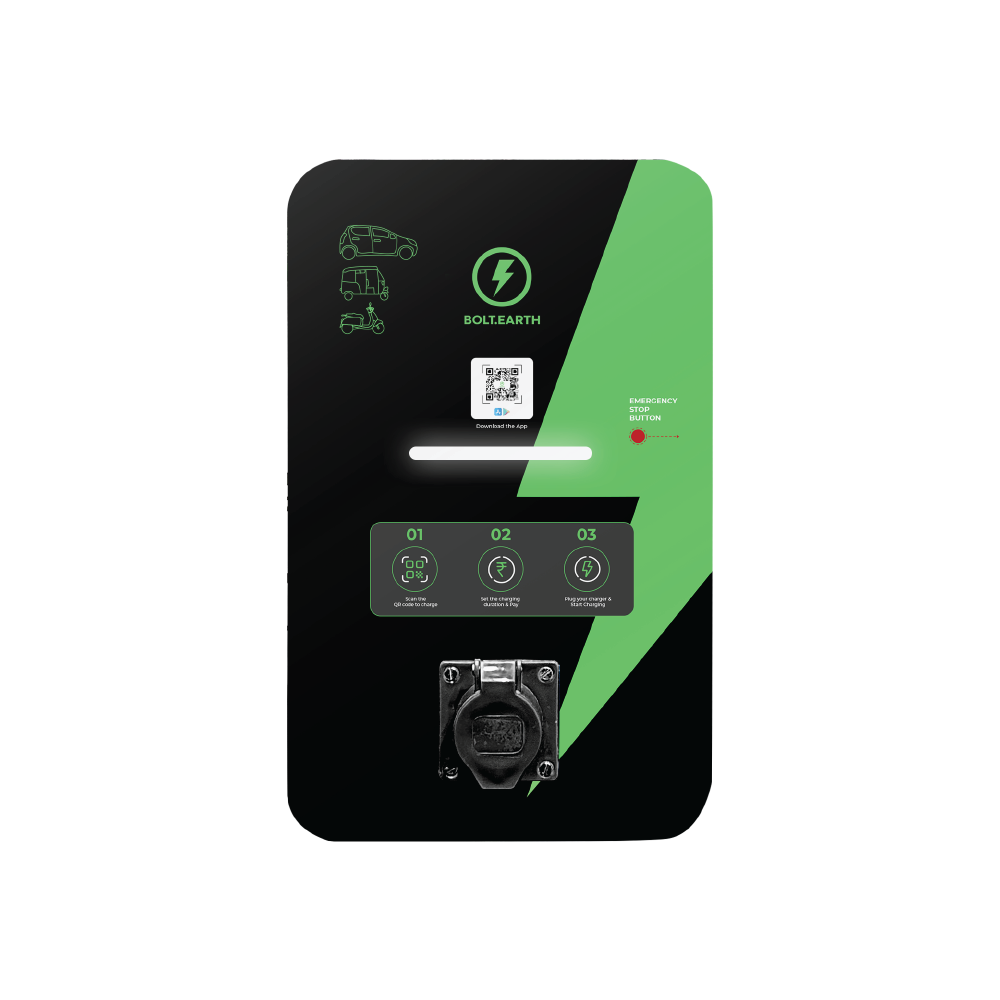Exploring the Role of Software in Advancing EV Adoption
Raghav Bharadwaj
Chief Executive Officer
Published on:
14 Mar, 2023
Updated on:
24 Nov, 2025

India today has the potential to revolutionize sustainable mobility in a way that hasn’t been since the early 1900s, providing transformational opportunities for players in the auto industry to reinvent themselves.
However, to succeed in this mobility transformation, the auto industry can’t rely solely on EV manufacturing and production, but must also look into the technology and software that will enable the new “computers on wheels” to become ubiquitous.
In particular, auto-makers require the DNA, or the Operating System (OS) to power the new EVs and build the ecosystem that will drive EV adoption. That said, automakers are expert car manufacturers, but usually don’t have the technical know-how and experience to successfully build EV operating systems.
This is where collaborative partnerships with EV OS makers can help develop and implement advanced EV software solutions that will support the safe, efficient, and reliable operations of these vehicles.
At the heart of every software-enabled system is an operating system. Take the case of your smartphone, for example. Though you have many apps for doing different things, it’s the underlying Android or iOS operating system that enables you to use these apps and provides a seamless user experience. Similarly, an OS will enable communication among the different EV components while providing a safe and reliable driving experience.
- In this article, we focus on three key questions:
- What are the current challenges in EV software?
- Why does the EV industry need to upgrade its software?
- How can EV software solutions optimize EVs?
Challenges for The Indian EV Market
Though EV OS is already playing a critical role in the EV industry, several challenges in software development and hardware mapping continue to impede the sustainable development and adoption of EVs in India. This is a common challenge faced by many countries, including China, one of the most dominant and comparable global EV markets today.
According to Miao Wei, the former Minister of Industry and IT in China, two prominent issues continue to plague the Chinese EV industry: 1) semiconductor shortages and 2) lack of comprehensive and advanced operating systems.
Conversely, India has a rich talent pool of software engineers and supportive government policies, so the country may not face the same issues as China. That said, obstacles persist among the EV software industry.
Below we take a detailed look at four primary challenges and explore what needs to be done.
1. Integration with Hardware
The Challenge
EV software is multilayered and interacts with different pieces of hardware through its tech stack. For example, the surface layer of EV software connects cars to phones, while the layer below it is the infotainment layer that handles GPS, touchscreens, air conditioning, etc. The base layer is the mission-critical layer that connects with different sensors and chips to ensure the car is functioning as it should.
From a maintenance standpoint, EV software must be able to send accurate analytics and diagnostics data in real-time to help technicians troubleshoot problems efficiently. But this extensive and complex software stack can’t function properly without a well-developed OS that can integrate different types of hardware from multiple vendors.
The Solution
Industry bodies can create standards for software makers to follow, ensuring compatibility with all different hardware layers. Properly developed communication protocols will also ease this problem, improving communication speeds and the vehicle’s efficiency. Furthermore, universal adoption of an EV OS can create an ecosystem for powering different applications.
2. User Experience (UX)
The Challenge
Good UX allows every individual to customize their EVs to match their preferences. Ideally, a vehicle’s UX should enable users to interact with all the different controls in their car. But creating great UX requires an ecosystem that scales well to support the vehicle’s operations and the user’s preferences.
The Solution
UX designers can leverage the power of AI and machine learning to customize user experience. They can also tap into the power of an OS to offer incremental updates to the UI, which in turn, will help meet different customers’ needs and accelerate the shift to EVs. When built and scaled properly with an advanced operating system, UX can also help EVs become more secure and reliable, improving EV drivers’ overall experience.
3. Security
The Challenge
A recent report by Upstream Automotive shows the frequency of cyberattacks on cars has increased by 225% from 2018 to 2021. This exponential rise was most likely due to EVs becoming more advanced and therefore requiring additional technology, resulting in a larger attack surface.
The Solution
Every EV software maker must make cybersecurity an essential component of the development process. To do that, they must use up-to-date cloud services to manage charging stations. Software makers should also secure drivers’ personal information, using chargers with role-based access to prevent misuse. Furthermore, an OS can provide greater control and visibility, leading to early detection and remediation of threats. Although these measures won’t completely eradicate security threats, EV software powered by a state-of-the-art OS will surely improve EV safety.
4. Interoperability
The Challenge
EV drivers currently rely on mobile applications and access cards to use charging stations operated by different providers. However, each provider’s access card only works at their station, which is highly inconvenient for drivers. This also increases range anxiety as drivers may struggle to find a charging station compatible with their cards.
The Solution
Unified access will improve the charging process’ efficiency, increasing EV adoption rates. Additionally, the CEEW Center for Energy Finance in India is encouraging charging point operators, EV platforms, and mobility service providers to create compatible systems.
To address the above challenges and deliver the best possible driving experience to EV consumers, the auto industry must continue to partner with EV OS makers who offer a single, cohesive tech stack for all EV software applications.
The Need for Upgraded Software in Today’s Market
Change is permanent, as old technologies give way to new ones. Rewind to Nokia and Blackberry, which dominated the cellphone market until Apple, Samsung, and Google emerged with new technologies. Similarly, the EV industry is likely to replace traditional ICE vehicles soon due to the rapid innovation occurring in the EV software space. EV OSs make it easy to send Over-The-Air (OTA) updates, and open up opportunities to create EV software with new features that reflect changing consumer expectations and the market as a whole.
Below we examine four key drivers behind upgraded EV software.
1. Competitive Landscape
Competition is heating up in the Indian EV market, thanks to a substantial push from the Indian government. For instance, India’s Faster Adoption and Manufacturing of (Hybrid and) Electric vehicles (FAME) is creating more charging stations and providing incentives for consumers to purchase EVs. Consequently, we see many private players entering the Indian EV space.
To stay ahead of the competition, more OEMs are incorporating AI and self-healing algorithms that can reduce operational issues by 80%. At the same time, OEMs must also partner with EV OS providers to bring down total cost of ownership and boost EV adoption. To keep up with the competition, EV operating system developers need to upgrade to an OS that powers AI.
2. Cybersecurity
Governments worldwide are coming up with stringent standards for EV software like the TR 25 2022 in Singapore to battle the increase in cyberattacks. Every EV software maker today has to acknowledge these requirements and tailor their platform to comply with them.
This increased focus on cybersecurity will therefore likely push EV manufacturers to embrace an advanced EV OS that supports built-in security mechanisms.

3. Scaling Infrastructure
According to current estimates, high capital costs, incompatibility among charging providers, and numerous other issues represent a major gap between the currently available charging infrastructure and the anticipated growth. Unfortunately, this gap negatively impacts the country’s ability to scale and impedes adoption.
But this discrepancy could push EV software tools and applications to evolve and bridge the gap. For instance, some advanced tools built on a cohesive OS can suggest the best place for EV infrastructure providers to set up new stations. Software apps may also help drivers plan their trips. Additionally, next-generation EV software tools can leverage machine learning-powered systems to forecast the future EV requirements of a community or city.
4. Fleet Management
As fleet operators shift to EVs, they are seeking streamlined solutions to consolidate and manage their EVs. Doing so should help them improve the overall user experience and gain a higher ROI.
An EV OS can integrate hardware, software, and data solutions from multiple vendors, helping operators generate more accurate data about their fleet’s charging status. More advanced versions of EV software will also have the potential to provide all data analytics in real-time through a single pane. This will help fleet operators make more informed decisions quickly.
Changing business dynamics and the adoption of a comprehensive EV OS will thus play a crucial role in the development of EV software ecosystem. In the next section, we examine what EV software makers can do to address the current challenges and leverage future opportunities.
Optimizing Solutions Through EV Software
Optimizing EV software is essential to maximizing the benefits of electric mobility and overcoming the greatest challenges that the EV software industry is facing. Doing so can also help encourage greater adoption in the coming years.
Below we look at three ways EV software makers and OEMs can optimize EV software for the future.

1. Hardware-Software Integration
Trends like Vehicle-to-Anything (V2X) connectivity and energy-efficient powertrain solutions are fueling the demand for centralized control of vehicle functions. This in turn is driving up the need for highly efficient and heterogeneous multicore processors and a forward-looking OS that can handle this increasing load.
To meet these changing needs, software experts are designing a flexible software architecture. Doing so will help meet the demand for seamless communication among different hardware components. As a result, the software will support faster processing, improved efficiency, and scalability to add new applications and mapping.
2. User-Centered Design
EVs present a unique opportunity for many innovative designs and interior spaces that can be customized to meet customers’ specific needs. As the EV market develops with new features and technologies, a user-centered design is emerging as a viable option.
In this model, OEMs can take the different blocks of software, customize them to meet their vehicle model’s specific requirements, and build their own products on top of an OS that supports this modular approach. A user-centered design also brings together user experience and software development processes for quick scalability.
3. Data Security
Connected vehicles can currently transfer information from charging stations to a whole network of vehicles. But this creates a major data security threat. Even a small misstep along this communication pipeline can have a disastrous security impact.
To address the growing cybersecurity challenges, many governments and industry bodies are developing standards and frameworks like UL 4600, SOTIF, and ISO 26262. These standards govern data handling, AI and ML use of data, operational feedback, and the data pipeline.
As a result, EV software must be optimized to meet these emerging requirements. Software makers will also have to leverage the capability of a mature OS to integrate cybersecurity processes like penetration and fuzz testing at every stage of the development lifecycle. Doing so will reduce rework rates and make EVs more secure.
Colossal Impact for The Future
As the EV market continues to expand and evolve, industry stakeholders need to focus on adopting an advanced OS for building comprehensive and seamless software solutions to ensure a secure, efficient, and reliable transition to electric mobility.
EV software has the potential to provide a wide range of benefits, including increased efficiency, sustainability, and cost savings for EV owners. Additionally, the optimization through EV software can lead to longer battery life, faster charging times, and better overall performance of EVs. EV software can also enhance operations and streamline maintenance, reducing costs for manufacturers and consumers alike.
Overall, leveraging the power of an EV OS to build an EV software ecosystem is critical for unlocking the full potential of electric mobility. When done properly, EV software can also address many of the obstacles currently facing the industry. If companies focus on the three solutions above, they can improve the efficiency, safety, and user experience of their EV software solutions. This, in turn, can have a significant, positive impact on the future of EV adoption in India.
To learn more about EV Software, please see the FAQ and Resources sections below.
FAQ
How does EV software impact the ecosystem of India?
The impact of EV software on the ecosystem of India is multi-faceted, ranging from environmental benefits to economic opportunities. India can use software to optimize electric mobility, which will help it build a sustainable, low-carbon future. Developing EV software will also help provide jobs to India’s young and tech-savvy workforce.
How does EV software impact the Indian automotive industry?
EV software has the potential to disrupt the Indian automotive industry and create new growth opportunities. The Indian government’s EV push has created a new market for EV software providers to develop and sell their solutions to automakers, charging infrastructure providers, and fleet operators. Additionally, EV software can make the Indian automotive industry more sustainable and environmentally friendly.
How does EV software impact the Indian government’s EV initiatives?
The adoption of EV software can help address critical EV adoption blockers like range anxiety, charging infrastructure, and battery performance. EV software solutions can also optimize charging patterns and grid integration. This makes EVs more cost-effective and reduces the burden on the power grid. With these varied impacts, EV software can help the Indian Government achieve its ambitious target of 30% electric vehicle penetration by 2030.
How does EV software impact the Indian consumer market?
EV software has the potential to enhance the performance and efficiency of EVs, making them more attractive to consumers. EV software has also led to the creation of new services that help address consumers’ key concerns. Moreover, the increased adoption of EVs is expected to lead to lower operating costs, which could incentivize consumers to switch to EVs.
What challenges does the Indian EV software industry face?
The Indian EV software industry faces challenges like limited standardization, low R&D investment, and cybersecurity risks. Addressing these challenges is vital for the long-term success of the industry. Though many initiatives are starting to develop seamless EV software, the results are not yet tangible enough to impact the EV industry.
Resources
Bolt.Earth: Official Website
Learn about Bolt.Earth’s products and services on our official website.
EVReporter: How EV Software Enables Smart and Connectivity Features
Learn why EV software is crucial to improving the overall EV driving experience.
Intellias: What Software Is Essential for Electric Vehicles?
Understand the challenges EV software must overcome in the Electric Vehicle industry.
eFaraday: Why Software Is So Important in Electric Vehicles
Learn about the different types of software used in EVs and why they’re crucial.

Jan 07, 2026 • EV Events and Industry Reports
Maharashtra’s New Electric Vehicle Policy (2025–2030)
Read More



